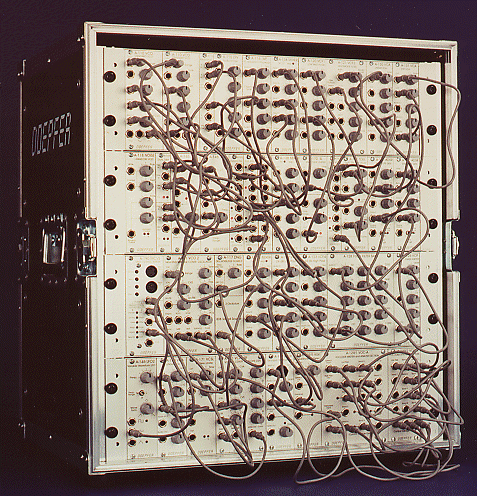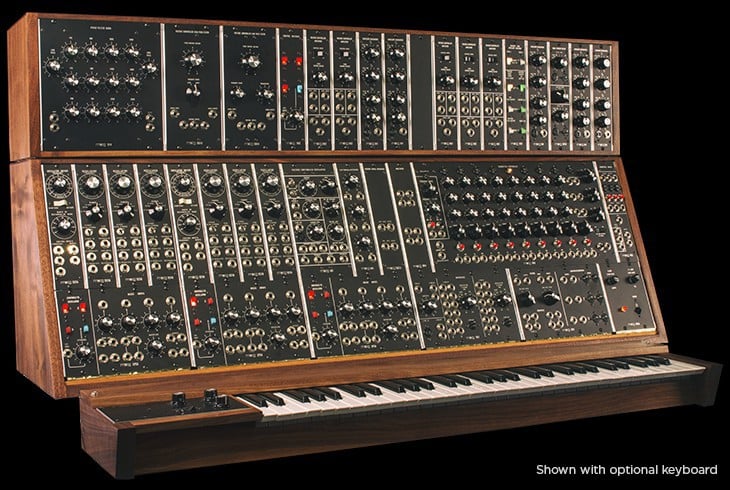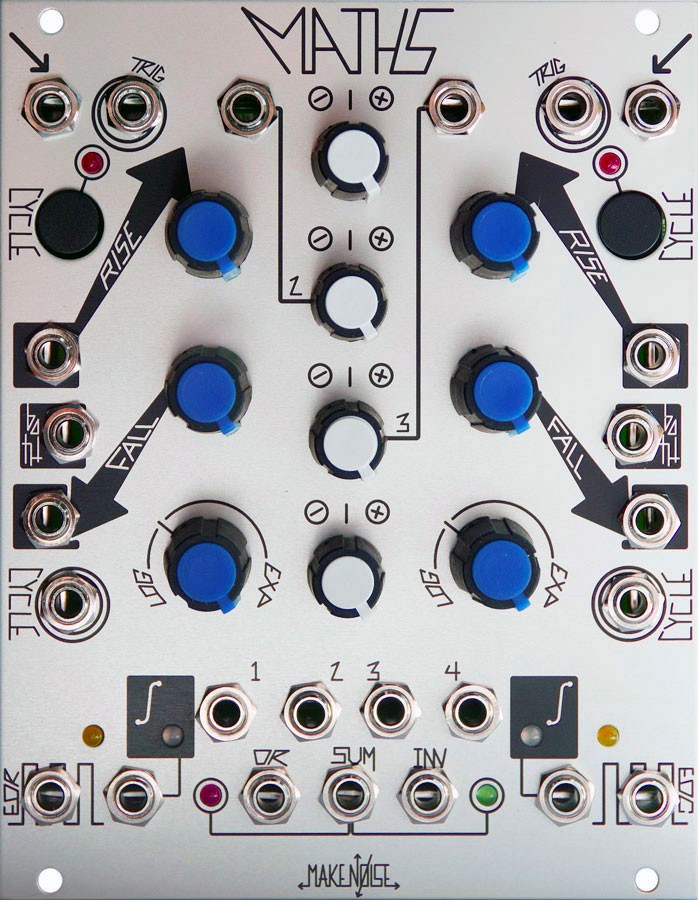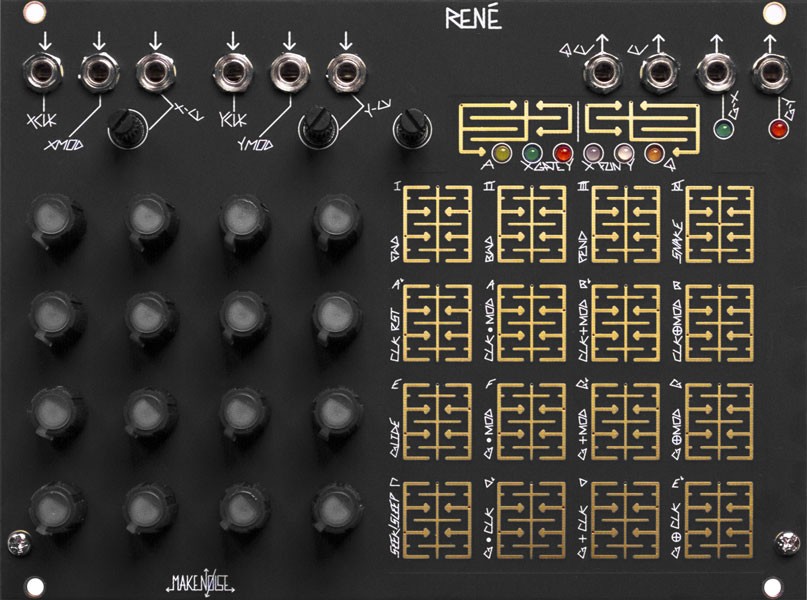WHAT IS EURORACK?
Eurorack is a modular synthesizer format that was created in Germany by Dieter Doepfer in 1995, when he first produced the Doepfer A-100 system. The Eurorack format specifies the form factor and electrical characteristics of the system: the height, widths, power connector and signal standards for the module and case components that are used to build the synthesizer instrument.

Doepfer A-100 rack
Any module, case and power supply in the Eurorack format should be compatible with all other Eurorack modules, power supplies and cases. For about a decade, Doepfer quietly designed and built an exhaustive collection of synthesizer modules in the Eurorack format with few others joining in on the fun. However, by around 2008 a small handful of companies had been created with the sole purpose of designing and building more synthesizer modules for the Eurorack format. Companies such as Livewire, the Harvestman (today known as Industrial Music Electronics) and Plan B were among the earliest American Eurorack synthesizer manufactures. Inspired by The Harvestman, I founded Make Noise in 2008.
[RELATED: What’s Behind The Resurgence of Analog Synthesizers?]
GROWTH OF THE EURORACK FORMAT
By 2013 there were nearly 100 companies producing synthesizer modules in the Eurorack format! The format has continued to grow and today nearly every style and technique of synthesis is well represented in the Eurorack format, from the East Coast techniques which were perfected on Moog Modulars, to the West Coast techniques innovated on the Buchla 200 Series, Granular Synthesis, Additive Synthesis and even techniques that have yet to be named. The Eurorack synthesizer revolution has brought electronic music into what is truly the era of No Coast Synthesis, where musicians utilize techniques and circuits from throughout the history and geography of electronic music, all while keeping at least one ear pointed toward the future, listening for new inspiration.

Moog System 55 Modular Synthesizer
HOW TO BUILD YOUR OWN EURORACK SYSTEM
Building a modular synthesizer is like designing your own electronic musical instrument and understanding the instrument you build and the components that compose it requires some studying of electricity and physics.
Today there is so much documentation and content surrounding modular synthesis that if you have the interest and motivation to learn about it, you will. For example, our own Make Noise YouTube channel has over 100 videos, many of which exhibit patch techniques using Make Noise modules but that could be carried over to other makes of modules as well. For folks just getting started, the YouTube channel Tuesday Night Machines has a series about “Modular Synth Basics.”
It is quite easy to submerge yourself in an endless cycle of system planning. For this reason, I often recommend to folks just getting started that they have a look at the complete systems offered from companies such as Make Noise. Even if you do not purchase a complete system from us, it could offer some perspective and guidance in putting together your own musical instrument.
[RELATED: Exploring the Legacy of Bob Moog]
WHICH MODULES ARE MOST ESSENTIAL
Most of our systems contain a core collection of modules: VCO, LPG, Modulation Sources and a Sequencer. There are many types of modules that could be added to a system, such as filters, digital effects and voices, clock manipulators, voltage controllable mixing surfaces and more, but the core system described below will provide a solid base regardless of what else is added. Keeping a system balanced is important to the inspirational feel of the instrument.
THE VCO
The VCO is a Voltage Controlled Oscillator, the primary sound source of the instrument. There are many VCOs available, but I would recommend a VCO that has some form of timbral animation integrated into the module. We make two different VCOs at Make Noise. One is smaller and lower cost, it is called the STO, or Sub-Timbral Oscillator. The other is called DPO, or Dual Prismatic Oscillator. Both of these VCOs are capable of timbral animation. What is nice about that is that with not much more than a Low Pass Gate and a Function Generator it is possible to create a pleasing, complex sound.
THE LOW PASS GATE (LPG)
The LPG is a Low Pass Gate, which gently sculpts the timbre and controls the dynamics or amplitude of the instrument. The LPG is a combination of the Low Pass Filter and Voltage Controlled Amplifier that are commonly found in monosynths. The sound is quite different because the filter portion is not as dramatic as the traditional VCF (voltage controlled filter), and the VCA (voltage controlled amplifier) portion is slower and more organic sounding. Combined with a VCO that features Timbral Animation, you could achieve many sounds that are unique and different from the traditional monosynth. A great example of the Low Pass Gate is the Make Noise Optomix.

Make Noise Optomix
MODULATION SOURCES
Modulation Sources are what make the modular synthesizer go! Without modulation your instrument is not complete and you will not be taking complete advantage of the modular form factor. It is like trying to drive a car without getting any gas. I always recommend folks to start with a Function Generator and when possible add a Random Voltage Generator. The Function Generator is useful in almost every patch. It allows for creating predictable changes in the sound of your instrument. You could use it to create Envelopes and LFOs (low frequency oscillators) amongst other things, and is perfect for sweeping parameters related to timbre or amplitude or even pitch. The MATHS module is an excellent Function Generator.

Make Noise MATHS module
RANDOM VOLTAGE GENERATOR
The Random Voltage Generator is more esoteric, but it could bring a level of uncertainty to your instrument that proves to be exciting and inspiring. Random Voltage Generators create control voltages that are not predictable, but a good random voltage generator offers some control over how these un-predictable voltages are created. For example, the Wogglebug allows for control over the Rate at which the random voltages are changing and also the maximum amount of change. This helps to craft how dramatic the random modulation will be. These types of Random Modulation are wonderful for animating timbre or modulating a more periodic modulation source. Yes, you are able to modulate the modulation!
SEQUENCERS
A Sequencer completes the instrument, allowing you to craft musical passages by programming changes in pitch, timbre and creating musical events. If you use MIDI to CV (control voltage) with a DAW, the sequencer might be less important, but if you desire a complete instrument that is capable of operating outside the DAW environment, then a Sequencer is a must. Even if you do not sequence melodies, you could sequence timbre, tempo and anything else that is voltage controllable. Make Noise offers two sequencers, the René and BRAINS/ Pressure Points both of which also allow human manual control using touch-plates. The René sequencer is best for melodic sequencing while the BRAINS/ Pressure Points is best for sequencing timbral and timing shifts.

Make Noise Rene Sequencer
POWER SUPPLY & CABLES
In addition to a functional selection of modules, you will need a case with a power supply and at least 10 patch cables. Patch cables are pretty inexpensive, so always get more if possible. There are many power and case options available from Doepfer, Make Noise, Goike, Enclave, Tip-Top Audio, 4ms and more. Do some research, as some of the lower cost solutions that are available are not as reliable. While a case and power supply is not the most exciting thing to buy when building a modular synthesizer, it is a VERY important component of your system! With a good power supply your modules will work properly and a good case design, one that fits your needs, will make using your system easier and more fun.
Portable cases are usually more expensive, but if you plan to travel with your system, take it in and out of studios or on and off stage, the extra expense will be nothing compared to the convenience it affords.
ABOUT THE AUTHOR
Tony Rolando is a self-taught electronic musical instrument designer who got started by obsessively reading amateur radio books at the public library, building electronics for artists, such as the light controlled mixer for Simon Lee’s “Bus Obscura,” working for Moog Music, and playing in bands for many years. After three years of isolation on a mountaintop, he founded Make Noise. In his spare time, he enjoys walking the dog, traveling with Kel and skateboarding.
What do you think of this special guest article about building your own Eurorack modular synthesizer? Let us know in the comments below or drop a line on the Performer Magazine Facebook page or on Twitter @Performermag. And be sure to read more from the special Synth Issue of Performer Magazine.

